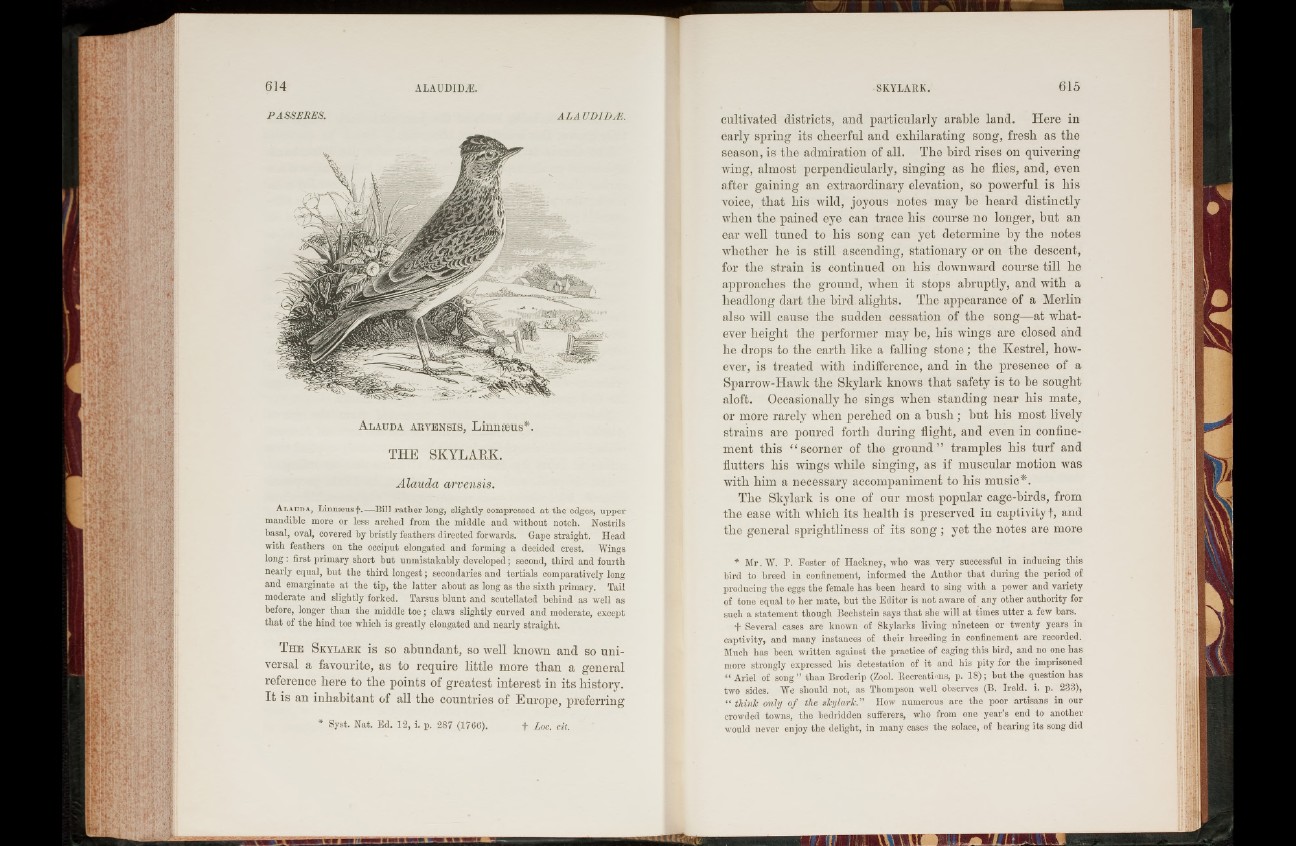
A la u d a ARVENSIS, L in n fflU S * .
THE SKYLARK.
Alauda arvensis.
A la ud a , Linnffiusf.—B ill rather long, slightly compressed at the edges, upper
mandible more or less arched from the middle and without notch. Nostrils
basal, oval, covered by bristly feathers directed forwards. Gape straight. Head
with feathers on the occiput elongated and forming a decided crest. Wings
long: first primary short but unmistakably developed; second, third and fourth
nearly equal, but the third longest; secondaries and tertials comparatively long
and emarginate at the tip, the latter about as long as the sixth primary. Tail
moderate and slightly forked. Tarsus blunt and scutellated behind as well as
before, longer than the middle to e ; claws slightly curved and moderate, except
that of the hind toe which is greatly elongated and nearly straight.
T h e S k y la rk is so abundant, so well known and so universal
a favourite, as to require little more than a general
reference here to the points of greatest interest in its history.
It is an inhabitant of all the countries of Europe, preferring
* Syst. Nat. Ed. 12, i . p. 287 (1766). + Loc. cit.
cultivated districts, and particularly arable land. Here in
early spring its cheerful and exhilarating song, fresh as the
season, is the admiration of all. The bird rises on quivering
wing, almost perpendicularly, singing as he flies, and, even
after gaining an extraordinary elevation, so powerful is his
voice, that his wild, joyous notes may be heard distinctly
when the pained eye can trace his course no longer, but an
ear well tuned to his song can yet determine by the notes
whether he is still ascending, stationary or on the descent,
for the strain is continued on his downward course till he
approaches the ground, when it stops abruptly, and with a
headlong dart the bird alights. The appearance of a Merlin
also will cause the sudden cessation of the song—at whatever
height the performer may be, his wings are closed and
he drops to the earth like a falling stone; the Kestrel, however,
is treated with indifference, and in the presence of a
Sparrow-Hawk the Skylark knows that safety is to be sought
aloft. Occasionally he sings when standing near his mate,
or more rarely when perched on a b u sh ; but his most lively
strains are poured forth during flight, and even in confinement
this “ seorner of the ground” tramples his turf and
flutters his wings while singing, as if muscular motion was
with him a necessary accompaniment to his music*.
The Skylark is one of our most popular cage-birds, from
the ease with which its health is preserved in captivity f, and
the general sprightliness of its song ; yet the notes are more
* Mr. W. P. Foster of Hackney, who was very successful in inducing this
bird to breed in confinement, informed the Author that during the period of
producing the eggs the female has been heard to sing with a power and variety
of tone equal to her mate, but the Editor is not aware of any other authority for
such a statement though Bechstein says that she will at times utter a few bars.
+ Several cases are known of Skylarks living nineteen or twenty years in
captivity, and many instances of their breeding in confinement are recorded.
Much has been written against the practice of caging this bird, and no one has
more strongly expressed his detestation of it and his pity for the imprisoned
“ Ariel of song” than Broderip (Zool. Recreations, p. 18); but the question has
two sides. We should not, as Thompson well observes (B. Ireld. i. p. 233),
“ think only o f the skylark.” How numerous are the poor artisans in our
crowded towns, the bedridden sufferers, who from one year’s end to another
would never enjoy the delight, in many cases the solace, of hearing its song did